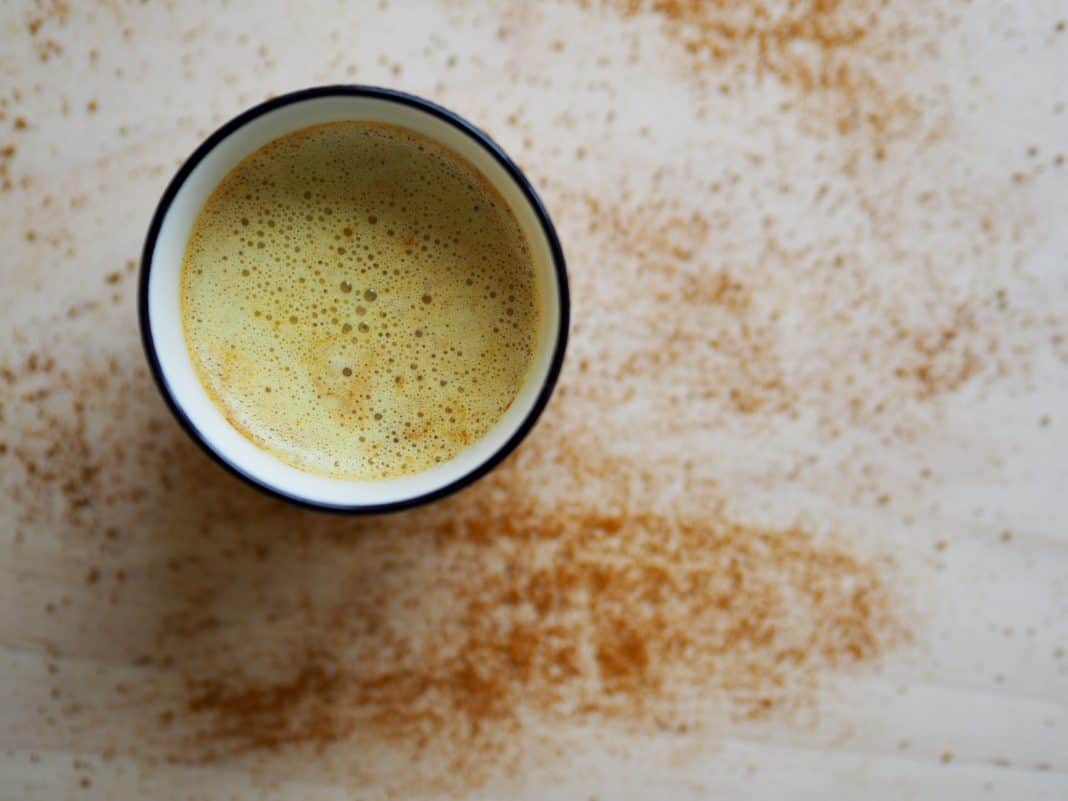Golden milk, golden lattes, and turmeric tea! Recently you may have come across a variation of these soothing turmeric-based drinks at your favorite coffee shop, in a vegan restaurant, or on various social media channels. Golden milk’s sudden surge in popularity is understandable. Thanks to its sunny hue, this is one photogenic beverage; a quick search of the hashtag #goldenmilk yields hundreds of results on Instagram alone. But what is it that makes golden milk so special among the hyper health-conscious? It turns out golden milk has a long history of being used for its anti-inflammatory effects, along with a whole host of other rumored benefits pertaining to digestive health, weight loss, joint pain, and even cancer prevention.
The Origins of Golden Milk
The history of golden milk goes back thousands of years and finds its roots in traditional Chinese and Indian Ayurvedic medicines. Turmeric, the spice used in golden milk that gives the drink its fabulous yellow color, has been used in various traditions, including Chinese medicine and Ayurveda to treat digestive issues, inflammation problems such as arthritis and menstrual pain, and to help improve liver function. While some of the health claims associated with turmeric and golden milk are still undergoing clinical trials, certain benefits of the brew have already stood up to the test of time.
Turmeric: The Golden Spice
Turmeric is the star of golden milk. It’s a golden spice that can be used in its fresh or dried forms. Currently the darling of health and food blogs all over the world, turmeric sales in the U.S. alone are projected to almost double by the year 2020. Turmeric has been credited as a miracle cure for anything that could possibly ail you, including diagnoses from depression to diabetes.  Is this too good to be true? The short answer is “possibly,” but a more in-depth answer is still in the works as scientists, registered dietitians, and researchers study its effects.
Is this too good to be true? The short answer is “possibly,” but a more in-depth answer is still in the works as scientists, registered dietitians, and researchers study its effects.
All About Curcumin
Turmeric contains curcumin, a chemical compound that is responsible for all of the perceived health benefits turmeric has to offer. Curcumin is a powerful antioxidant that is believed to be even more powerful than both vitamin C and E when it comes to its ability to repair damaged cells. Curcumin has also shown great promise as an anti-inflammatory agent, a finding that could warrant it being used in the treatment of a long list of medical conditions. Amanda Li, a registered dietician and owner of Wellness Simplified, is excited about the potential effects these studies might have on the treatment of chronic inflammation, saying “There is mounting evidence supporting curcumin’s role in inhibiting the inflammatory process, and thus reducing chronic diseases including obesity, type 2 diabetes, heart disease, and Alzheimer’s disease.” While clinical studies are still in their early stages, there are promising results that show that there may be some scientific truth to turmeric’s legendary holistic healing powers.
A Note on Curcumin Absorption
Curcumin may seem like a dream nutrient, but one of its drawbacks is that it’s difficult for your gastrointestinal tract to absorb. Li cautions, “It is important to note that curcumin, the active ingredient in turmeric, is fat-soluble, and absorption is enhanced when combined with black pepper and dishes that contain fat, such as coconut, fish, olive oil, and avocado.” According to one study, 20 milligrams of ground black pepper ingested along with curcumin increased curcumin absorption by up to 2000 percent, which may account for why turmeric is so often paired with black pepper in traditional curries. However, these studies are still in their very early stages, and malabsorption remains one of the biggest issues to overcome in clinical trials on humans.
Turmeric: Fresh Versus Dried
Turmeric is most commonly found in powdered form, although whole dried turmeric can be purchased from natural food stores and well-stocked Asian grocery stores. Fresh turmeric rhizomes, also known as turmeric roots, are closely related to fresh ginger rhizomes. Small and unassuming, fresh turmeric roots have a vivid yellow–orange interior and a mildly peppery flavor. Like ginger, young turmeric rhizomes can be used skin and all. However, older roots should have their tough skins removed with a knife, spoon, or potato peeler. Fresh turmeric should be stored loosely wrapped in the fridge or sliced thinly and frozen for up to several months before you use or discard it. Dried turmeric is made of turmeric rhizomes that have been boiled and then dried. Dried turmeric ranges in color from bright yellow to burnt orange and has an earthier flavor than fresh turmeric. Dried turmeric should be stored in a glass jar away from heat and direct sunlight. As with other spices, dried turmeric should be purchased from a reputable shop with frequent product turnover to ensure freshness. Unless a recipe specifies otherwise, fresh and dried turmeric can be used interchangeably. As a general rule, 1 inch of fresh turmeric is equal to 1 tablespoon of grated or finely minced turmeric, which is equal to 1 teaspoon of dried turmeric.
Golden milk, but which milk?
Golden milk’s introduction into the Western world has largely coincided with the variety of vegan milks on the market, and its reputation as a healing tea has found golden milk right at home on the menus of natural food and plant-based restaurants. Traditional Indian recipes generally call for organic dairy milk, whereas modernized versions are often made with soy, rice, or nut milk. In short, the type of milk you use for golden milk is entirely dependent on your tastes. If using dairy milk, make sure that it’s whole milk (i.e. has its full fat content), since low fat and skim milk tend to separate when heated.
To ghee or not to ghee?
Fat is an important part of any golden milk recipe, and ghee is one way you can get some fat in the mix. Ghee is essentially super-clarified butter, and it’s an important staple in Indian cooking. You can make ghee it at home or buy it. Ghee is shelf-stable and it’s often found in the international food sections of well-stocked supermarkets. Coconut oil, another food that’s risen through the ranks from humble ingredient to nutrition superstar, is often more readily available and will make an equally delicious addition to your next batch of homemade golden milk.
Making Golden Milk at Home
Golden milk has been made for thousands of years, so it’s no surprise there are endless variations on this traditional tea. Golden milk essentially comes down to a few ingredients—any additions are up to you. Experiment with grated fresh turmeric in lieu of the dried and look to your spice cupboard for inspiration—anything along the lines of pumpkin spice generally works well. If the thought of a caffeine-free hot drink makes you feel uneasy, a shot or two of espresso can be added to your golden milk. Golden milk can be kept in the fridge for up to five days; simply reheat it over the stove or in the microwave.
Golden Milk Your Way
2 cups of milk (whole, nut, soy, rice, or hemp) 1 Tbsp coconut oil or ghee 1 tsp dried turmeric or 1-inch fresh turmeric, thinly sliced or grated 1 tsp dried ginger or 1-inch fresh ginger, thinly sliced or grated 1 cinnamon stick ¼ tsp freshly ground black pepper 1 tsp honey Whisk all ingredients in a medium-sized saucepan and bring to a gentle boil over medium heat. Reduce heat to medium-low and simmer for 10 to 15 minutes to allow the flavors to steep. Strain the tea through cheesecloth or a fine colander or sieve. Then use a hand blender to froth up the golden milk and better emulsify the ingredients. Note that the frothing step is particularly useful when reheating the golden milk.
Variations on Golden Milk
-
Golden Milk Smoothies
 More a fan of smoothies first thing in the morning? The ingredients in golden milk are just as tasty when they’re combined in smoothie form. Add a dollop of coconut oil to your smoothie to help your body absorb as many nutritional benefits as possible.
More a fan of smoothies first thing in the morning? The ingredients in golden milk are just as tasty when they’re combined in smoothie form. Add a dollop of coconut oil to your smoothie to help your body absorb as many nutritional benefits as possible. -
Iced Golden Milk Latte
Iced golden milk lattes are a perfect on-the-go beverage that can be made quickly when you have leftover golden milk. For a real treat, freeze a batch of golden milk in ice cube trays so that you can enjoy your chilled golden milk latte without any danger of ice cube dilution.
-
Golden Milk Bone Broth
This golden milk variation turns turmeric tea into a soothing and savory treat with the addition of ultra-rich bone broth. Take this nutrient-rich golden broth to work in a thermos on cold days. You’ll feel both warmed and energized by this turmeric-packed broth.
-
Golden Milk Paste
If making golden milk becomes a habit and you find yourself craving it all hours of the day, then it’s very much worth it to make a golden milk paste. This paste is essentially a golden milk concentrate that can be kept in the refrigerator for up to three weeks for almost-instant turmeric tea whenever a craving strikes.
What if golden milk isn’t your cup of tea?
If the thought of golden milk sounds downright unappetizing, don’t worry. There are countless other ways to get the benefits of turmeric without having to drink it. Li gives several examples of how she enjoys turmeric when it’s not in golden milk form:
-
Turmeric Rice
This is simply rice that has been steamed with the addition of turmeric and butter. Add finely chopped fresh herbs and green peas to round out the dish.
-
Turmeric Marinade
A turmeric-based marinade not only adds the benefits of curcumin to the dish; it also imparts a beautiful yellow color to whatever is being marinated. This recipe can be used to marinate chicken or white fish and also includes freshly cracked pepper that can help with absorption.
-
Curry With Turmeric
Turmeric is a central ingredient in many Indian curries, as is the case with this vibrant Turmeric Cauliflower Curry. If Thai curry is more your thing, you’ll be pleased to discover turmeric also plays an important role in Thai recipes such as Turmeric and Coconut Fish Curry, which features turmeric as a key ingredient.
-
Other uses for turmeric…
Add a pinch of turmeric next time you make scrambled tofu. It will give the tofu a bright yellow color that could fool any egg-lover into thinking they’re eating the real deal. Toss root vegetables such as sweet potato, turnip, and carrots with turmeric and olive oil before roasting. Or, next time you’re making curried butternut squash soup, add a teaspoon or two of turmeric to boost the nutritional value and deepen the orange color of the concoction.
A Word of Caution About Turmeric Stains
One unfortunate aspect of using turmeric (especially fresh turmeric) to make golden milk or any other recipe is its potent ability to stain surfaces on contact. Like beets, turmeric will transfer its bright color to anything it touches, including dishes, countertops, clothing, hands, and nails, which makes it a both great all-natural food dye and a threat to anything you want to keep from yellowing. To ward off stains, consider the following:
-
Dishes
The most important thing when dealing with turmeric stains is to act as quickly as possible. For most dishes, a solution of 2-to-1 hot water to bleach should work, especially when left to sit overnight. The same ratio can be used with white vinegar in place of the bleach, the only caveat being that it will take considerable more elbow grease to fully remove the stain.
-
Countertops
For countertops, use a paste made from equal parts baking soda and hot water to clean, spreading a thin layer and then allowing it to sit for 15 minutes before scrubbing clean with a sponge (if this ultimately fails, a Magic Eraser can be used on countertops without a glossy finish).
-
Clothing
Time is especially of the essence when it comes to clothing. Wash immediately with cold water and soap and allow your garment to air dry. Repeat as necessary to fully remove the stain.
-
Hands and Nails
Add lemon juice or a very small amount of hydrogen peroxide to a bowl with cold water and soak your hands to remove turmeric stains. Scrub them with hot water and soap to further lighten any stains that remain after the initial treatment.
For more information on this beautiful beverage, check out our video: https://www.youtube.com/watch?v=N5mXSVKtaNE&t=2s



